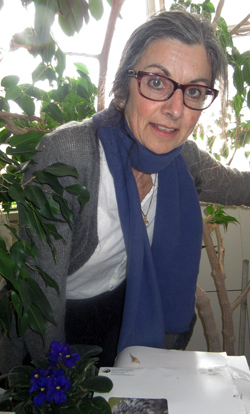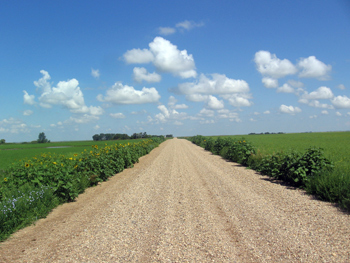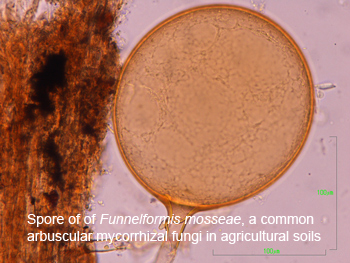The People Behind the Research
A Conversation with Dr. Chantal Hamel
Agriculture and Agri-Food Canada Semiarid Prairie Agricultural Research Centre
Activity A.9: Applying ecology for simple, nutrient use efficient pulse-based cropping systems: Phosphorus sources for organic growers of the Prairie, and agronomic strategies for effective soil microbiology to make better use of these P sources
 |
Industry Partners:
|
Collaborating Researchers:
|
Can you tell us a bit about yourself?
I come from Québec City, and studied at McGill University. I then worked for the Ministère de l'Agriculture, des Pêcheries et de l'Alimentation du Québec, where I had a chance to work with agrologists. This is where I started to become very interested in agriculture, particularly applied work in agriculture. I now work for Agriculture and Agri-Food Canada in Swift Current, Saskatchewan. I love the Prairies, particularly the native prairie, and the beautiful landscape that we have, the big sky.
Can you briefly explain your Research Activity in Organic Science Cluster II?
When left with unanswered questions, scientists often want to keep digging. That is the case with this activity, which stems from our work in the first Organic Science Cluster that explored phosphorus levels on Prairie organic farms and delved deep into the soil to examine soil biology. When faced with our findings that soil phosphorus is often low and shifts in soil biology in cultivated fields may be limiting yields on organic farms, we embarked on this activity in OSCII.
In OSCII, we are exploring potential phosphorus sources for Prairie organic growers, which often have limited access to inputs, due to locations, field sizes and expense. We will examine the impacts of using amendments, such as locally available composted animal manures and rock phosphate, to boost soil phosphorus.
We are also looking at ways to bolster soil diversity, in an effort to increase soil resilience and limit root-borne diseases in economically important crops such as lentil. We are exploring the impacts of mycorrhizal fungal inoculants and the use of diverse, mixed cultivar plantings on crop yield and soil communities.
What brought you to this research, and what excites you the most about this project?
The previous work that we did. Researchers are like that, we get excited about what we are doing! So, I want to answer some questions that were raised from the previous work, and, at the same time, try to improve the production of organic growers. We’re looking for ways to do more with what we have, to use soil resources better, rather than relying on inputs.
You were also involved in the first Organic Science Cluster. Can you briefly explain your project and its outcomes? Has your current Research Activity developed as a result of the first Organic Science Cluster?
[Editor’s note: Arbuscular mycorrhizal fungi live in symbiosis with their host plants, providing them otherwise unavailable soil nutrients, particularly phosphorus, in exchange for carbohydrates synthetized by the plant host.]
Our work in the first Organic Science Cluster revealed some very interesting and sometimes unexpected things about soil biology, particularly mycorrhizal fungi. We had very little knowledge of fungal diversity before this study, and this new base of information, and the other questions that it raised, led to our current research in OSCII.
 In the first Organic Science Cluster, we looked at the distribution of fungi in a range of soil environments, namely cultivated fields, native prairie and roadsides. We found that the fungal community shifts under these different environments. Fungal diversity was highest in the roadsides, which is good news because we have lots of roadsides that could be used to restore depleted soils. The native prairie and cultivated fields had about the same level of fungal diversity, although the communities are changed. So, agriculture is not wiping out mycorrhizal fungi, but shifting the prevalence of certain groups.
In the first Organic Science Cluster, we looked at the distribution of fungi in a range of soil environments, namely cultivated fields, native prairie and roadsides. We found that the fungal community shifts under these different environments. Fungal diversity was highest in the roadsides, which is good news because we have lots of roadsides that could be used to restore depleted soils. The native prairie and cultivated fields had about the same level of fungal diversity, although the communities are changed. So, agriculture is not wiping out mycorrhizal fungi, but shifting the prevalence of certain groups.
We found one fungi in particular, named Funneliformis mosseae, which becomes very abundant in agricultural soil, and can actually be used as an indicator of agricultural soils. We also discovered something unexpected: a mycorrhizal fungi that lives deep in the soil and that seems to have a negative impact on crops. We always thought that mycorrhizal fungi are invariably good, but this goes to show that, in nature, nothing is totally black or white.
Where is your project taking place?
We will have field sites in Swift Current, Saskatchewan on the Agriculture and Agri-Food Canada farm, as well as at another site in Beaverlodge, Alberta. We also hope to work on-farm, and are looking for volunteers. Growers will benefit by being able to see if treatments work on their fields, and we are trying to make it easy for farmers to participate, asking for one field that will have the treatment just once.
How do you envision that your research will help organic producers in Canada?
We hope that we can do our part for the organic industry. We want to further explore whether phosphorus is limiting yields on organic farms, and give farmers more information about their yield potentials. From there, we hope to show producers what resources are available on the Prairies. When looking at managing diversity, if we can increase yield, plant health and soil health with increasing diversity, then this is something that farmers could really use.
How have the organic community and your industry partners helped to shape your research?
During the first Organic Science Cluster, I visited many different farms. The people who volunteered for our study helped me a lot – if they had not let me take samples, put flags in their fields and such, I could not have done that research and might not have wanted to continue in this line of work. It was wonderful to talk to people in the field. I was in the middle of nowhere, and people would come to chat with me.
Are there graduate students, undergraduate students, or postdoctoral fellows involved in this research?
We currently have a post-doctoral fellow who is working part-time on this project. We are lining up a full time post-doctoral fellow, who will be starting soon. Summer students are also important, I know because that is how I started out, so we will also have summer students involved.
For more information on Chantal Hamel’s work in OSCII, please visit www.dal.ca/oacc. The full-length conversation with Chantal Hamel is available here. A print-friendly version of this article is available here [PDF - 482 kB].
The Organic Science Cluster II (OSCII) project described in this article is supported by the AgriInnovation Program of Agriculture and Agri-Food Canada's Growing Forward 2 (GF2) Policy Framework and industry partners. OSCII and this article are collaborative initiatives of the Organic Agriculture Centre of Canada at Dalhousie University and the Organic Federation of Canada.

